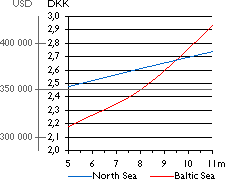
Offshore
Foundations: Mono Pile
The mono pile foundation is a simple construction. The foundation
consists of a steel pile with a diameter of between 3.5 and 4.5
metres. The pile is driven some 10 to 20 metres into the seabed
depending on the type of underground. The mono pile foundation
is effectively extending the turbine tower under water and into
the seabed.
![]() An important advantage of this foundation
is that no preparations of the seabed are necessary. On the other
hand, it requires heavy duty piling equipment, and the foundation
type is not suitable for locations with many large boulders in
the seabed. If a large boulder is encountered during piling,
it is possible to drill down to the boulder and blast it with
explosives.
An important advantage of this foundation
is that no preparations of the seabed are necessary. On the other
hand, it requires heavy duty piling equipment, and the foundation
type is not suitable for locations with many large boulders in
the seabed. If a large boulder is encountered during piling,
it is possible to drill down to the boulder and blast it with
explosives.
Costs
by Water Depth for Mono Pile Foundations

![]() The dimensioning
factor of the foundation varies from the North Sea to the Baltic
Sea. In the North Sea it is the wave size that determines the
dimension of the mono pile. In the Baltic Sea the pack ice pressure
decides the size of the foundation. This is the reason why the
mono pile foundation cost increases more rapidly in the Baltic
Sea than in the North Sea. The costs include installation (1997
prices).
The dimensioning
factor of the foundation varies from the North Sea to the Baltic
Sea. In the North Sea it is the wave size that determines the
dimension of the mono pile. In the Baltic Sea the pack ice pressure
decides the size of the foundation. This is the reason why the
mono pile foundation cost increases more rapidly in the Baltic
Sea than in the North Sea. The costs include installation (1997
prices).
Erosion
Considerations
Erosion will normally not be a problem with this type of foundation.
Swedish
Offshore Project
A 2.5 MW pilot project with five Danish wind turbines using the
mono pile technology has been installed in the Baltic sea south
of the Swedish island of Gotland.
![]() Using the mono pile foundation technique
at Gotland involved drilling a hole of 8 to 10 metres depth for
each of the turbines (Wind World 500 kW). Each steel pile is
slotted into the the solid rock. When the foundations are in
place the turbines can be bolted on top of the mono piles.
Using the mono pile foundation technique
at Gotland involved drilling a hole of 8 to 10 metres depth for
each of the turbines (Wind World 500 kW). Each steel pile is
slotted into the the solid rock. When the foundations are in
place the turbines can be bolted on top of the mono piles.
![]() The whole operation takes about 35 days under
average Baltic weather conditions.
The whole operation takes about 35 days under
average Baltic weather conditions.
![]()
|
Back | Home
| Forward |
© Copyright 2000 Soren Krohn.
All rights reserved.
Updated 9 September 2000
http://www.wind power.dk/tour/rd/monopile.htm